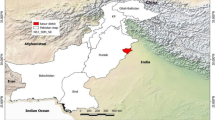Summary
The present study was carried at Theodorou island (68 ha) Crete, the national reserve for the conservation of the endangered Cretan wild goat. A big part of the habitat (39.9 %) was devoid of vegetation. The main vegetation class was shrubs (74.5%) where forbs and grasses represented 24% and 1.5% respectively. The most dominant shrubs throughout the island werePistacia lentiscus, Sarcopoterium spinosum, Thymus capitatus, Euphorbia dendroides, Calycotome villosa andPhlomis fruticosa. The diversity of the plant community (115 species) was estimated to be 3.9.
Through the prolonged span of overgrazing, the plant community has been altered to a disclimax community dominated mainly by invader species. In comparison to the past, invaders were increased and decreasers were decreased indicating the retrogression of the plant community and the degradation of the habitat. The range condition of the habitat was slightly poor resulting in problematic survival of the wild goat.
The total green biomass production of the whole island was estimated to be 120126 kg, 30 % of this production was not edible. The carrying capacity of the island was estimated to be about 48 adult animals, 17 animals less than in 1973 indicating a visible “ungulate irruption”.
Zusammenfassung
Die vorliegende Studie wurde auf der Theodorou-Insel (68ha), Kreta, dem nationalen Schutzgebiet zur Erhaltung der gefährdeten Kretischen Wildziege, durchgeführt. Gro\e Teile des Lebensraums (39.9%) waren vegetationslos. Die dominante Vegetationsklasse waren Sträucher (74,5%), während Kräuter 24% und Gräser 1,5% ausmachten. Die dominierenden Straucharten auf der Insel warenPistacia lentiscus, Sarcopoterium spinosum, Thymus capitatus, Euphorbia dendroides, Calycotome villosa undPhlomis fruticosa. Die Diversität der Pflanzengemeinschaft Pflanzengesellschaft (115 Arten) wurde auf 3,9 geschätzt.
Durch die lang andauernde überweidung hat sich die Pflanzengemeinschaft zu einer Disklimax-Gesellschaft gewandelt, in der fremde Arten dominieren. Verglichen mit der Vergangenheit haben sich Adventivpflanzen vermehrt, während einheimische Pflanzen zurückgedrängt wurden, ein Zeichen für die Rückentwicklung der Pflanzengesellschaft und die Degradierung des Lebensraums. Der Zustand des Weidelandes war relativ schlecht, was sein Problem für den Fortbestand der Wildziegen darstellt.
Die Biomasseproduktion der Vegetation der Gesamtinsel wurde auf 120126 kg geschätzt, von denen 30% nicht essbar waren. Die Tragfähigkeit der Insel wurde auf 48 erwachsene Tiere geschätzt, 17 weniger als im Jahr 1973, Anzeichen für eine übernutzung durch Huftiere.
Similar content being viewed by others
References
Braun-Blanquet, J., 1932: Plant Sociology. In: Measurements for Terrestrial Vegetation, ed.Bonham, C. D., New York, Chichester, Brisbane, Toronto, Singapore: John Willey Sons.
Krebs, C. J., 1989: Ecological Methodology. New York: Harper Collins Publishers.
Krebs, C. J., 1994: Ecology: The experimental Analysis of Distribution and Abundance. New York: Harper Collins Publishers.
Cain, S. A., 1938: The species-area curve. In: Measurements for Terrestrial Vegetation, ed.Bonham, C. D., New York, Chichester, Brisbane, Toronto, Singapore: John Willey Sons.
Harper, J. L., 1990: Population biology of plants. San Diego: Academic Press.
Hussain, I., 1968: Determination of forage production. Pakistan: Division of forestry research.
Mohamamad, R. S., 1992: Carrying capacity and range condition of Hazargangi-Chiltan national park. Pakistan Journal of Forestry.
Nastis, A. S., 1990: Range Management and Improvement. Greece: Mediterranean Agronomic Institute of Chania.
Papageorgiou, N. K., 1995: Ecology and Wildlife Management. Thessaloniki: University Studio Press.
Papageorgiou, N., 1972: Food preferences and survival of the Agrirmi (Capra aegagrus cretica) on Crete. M.Sc. diss., Michigan State University.
Papageorgiou, N., 1979: Population energy relationships of the Cretan Agrimi (Capra aegagrus cretica) on Theodorou island, Greece. Hamburg, Berlin: Parey.
Ricklefs, E. R.;Schlulter, D., 1993: Species Diversity in Ecological Communities. Chicago, London: The University of Chicago.
Scoula, M., 1989: The biology and conservation of the Cretan Agrimi (Capra aegragrus cretica). M. Sc. diss., Mediterranean Agronomic Institute of Chania.
Valentine, J. F., 1990: Grazing Management. London, San Diego, California: Academic Press.
Washington, H. J., 1984: Diversity, biotic and similarity indices: a review with species relevance to aquatic ecosystems. Water Res.18, 653–694.
Author information
Authors and Affiliations
Rights and permissions
About this article
Cite this article
Papadopoulos, M.C. Evaluation of Theodorou Island as a habitat for the conservation of the Cretan wild goat (Capra aegagrus cretica Schinz 1938) and the impact of grazing on vegetation. Zeitschrift für Jagdwissenschaft 48 (Suppl 1), 130–139 (2002). https://doi.org/10.1007/BF02192400
Issue Date:
DOI: https://doi.org/10.1007/BF02192400




